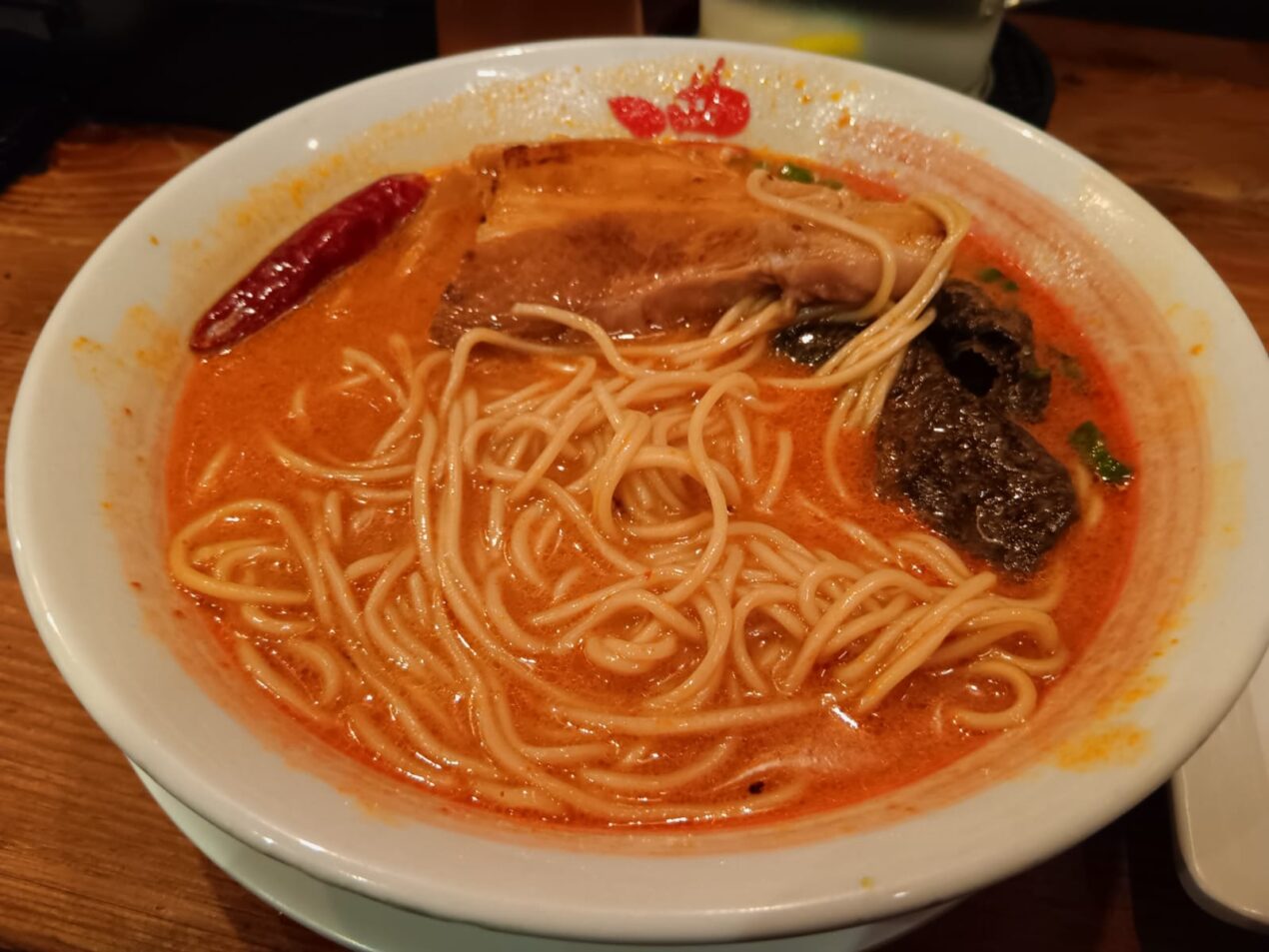A Tempestuous, Tonkotsu Tryst at Ramen Bari-Uma in Central
After three months back in Hong Kong (post-Japan stint), to say that I’ve been on a ramen kick is an understatement. I’ve touched on this in several other posts but other than ramen, I find most Japanese cuisine in Hong Kong to be exorbitantly priced. This Big Body wants consistent, high-quality, affordable Japanese fare (and nama beerus) that brings me back to my days falling off izakaya bar stools and waking up naked in the hallway of my Tokyo hotel (I wish I was joking).
Well, I found it and am thankful to Ramen Bari-Uma for delivering that shameful, delicious nostalgia in a piping hot bowl of tonkotsu-based ramen loaded with fat slabs of char siu. I like big cuts of char siu and I cannot lie.
By now, I’ve almost eaten through the entire menu at this bustling Lan Kwai Fong ramen haunt. Initially, I was in it for Bari-Uma’s spicy, rich tonkotsu ramens with thick cut slabs of fatty char siu (that I’d have to dial down a tad with nori slices by the dozen). But as I worked my way through, I found several new favorite dishes that have kept me coming back, at minimum, one per week for the last 3 months. Because of this, it’s only right that I dedicate an entire love song post to this ramen joint that should definitely be on your radar.
Ramen Bari-Uma, it’s your time to shine. Without further ado, here’s why Ramen Bari-Uma pumps me up Jock Jams, Volume 1-style when I’m down and out and in need of a pick me up to carry me through to the weekend.
Pale Ale Travel Tip: If you are looking for a more comprehensive post on the ramen landscape in Hong Kong, I recommend checking out my article breaking down my favorite ramen restaurants in Central.
Located in the Heart of Lan Kwai Fong

Website, Address, & Details: https://www.bariuma.asia/location/hkg_lankwaifong.html
- Address: 22號 D’Aguilar St, Central
- Price: $90 – $200 – For reference, I typically order one ramen/abura soba, karaage, gyoza, and a Coke Zero, and the total comes out to under HKD$200. So, if you eat a lot like me, then expect it to be far closer to HKD$200.
Look, I’ll level with you here – this isn’t the spot that you are going to go to and be greeted as my favorite late-90s rock band Creed would say, “With arms wide opennnnnnn.” I’m just kidding, they weren’t my favorite late-90s rock band, that was definitely Nickelback. Ba dum tss! I’ll see myself out. Ramen Bari-Uma is more on the Southie (Boston) Dunkin’ Donuts hospitality vibe grind. And I run on Dunkin’, kid. What you will find is a no-nonsense, well-oiled ramen making machine where every staff member moves with purpose and a Japanese side dish is no more than a two-minute wait.
From the second you sit down, a seasoned team member will nonchalantly slide a QR code for ordering in front of you. From there, it’s off to the races. I used to feign ignorance with not understanding how to scan the QR code to order via mobile, as I genuinely liked human interaction after a long day of typing away like that keyboard cat GIF. However, as I make Ramen Bari-Uma a more regular staple in my week, there’s just some days where my brain is fried and I’m unable to string together any sort of cogent thought.
QR code-ordering allows me to revert to my natural state – where I drool, point at pictures, and grunt, “Oooh, Big Body like. Big Body want.”
You’ll hear a faint ding and watch as the tonkotsu titan himself, in the open air kitchen, begins furiously ladling broths, frying gyoza and karaage, and delicately pirouetting amongst his close-quarters counterpart. There is inevitable discourse that arises when working in such close proximity with one another and you’ll hear it. Oh, you’ll hear it. A minor ramen rebellion off of D’Aguilar Street in Lan Kwai Fong is never too far off and you have a front row bar seat.
Side Note: Most people don’t actually know this but Ramen Bari-Uma was named after Uma Thurman in Kill Bill Vol. 1 – the full name of the restaurant is Ramen Bari-Uma Thurman. This is because of the small doses of revenge and vengeance that are worked into every bowl of their spicy tonkotsu (or abura soba). This is also complete gibberish that I made up.
Let’s have a look at what this tonkotsu roundhouse looks like once the bowl is slid in front of you.
A Spicy Tonkotsu Ramen: The Bari-Breaker of Hong Kong Ramens

“They call me the bari-breaker, you should kick me out the club.” – Prof
First, if you’re looking for a primer on what exactly tonkotsu ramen is, make sure to check out my ramen restaurant guide to Osaka, where I break down the four key types of ramen broth you’ll find. However, in a sentence – tonkotsu ramen is a pork-based broth made by boiling pork bones, collagen, marrow, and other parts of the pig, which results in a creamy, often thick liquid that pairs perfectly with soft-boiled eggs, seawood, char siu, and countless other vegetables.
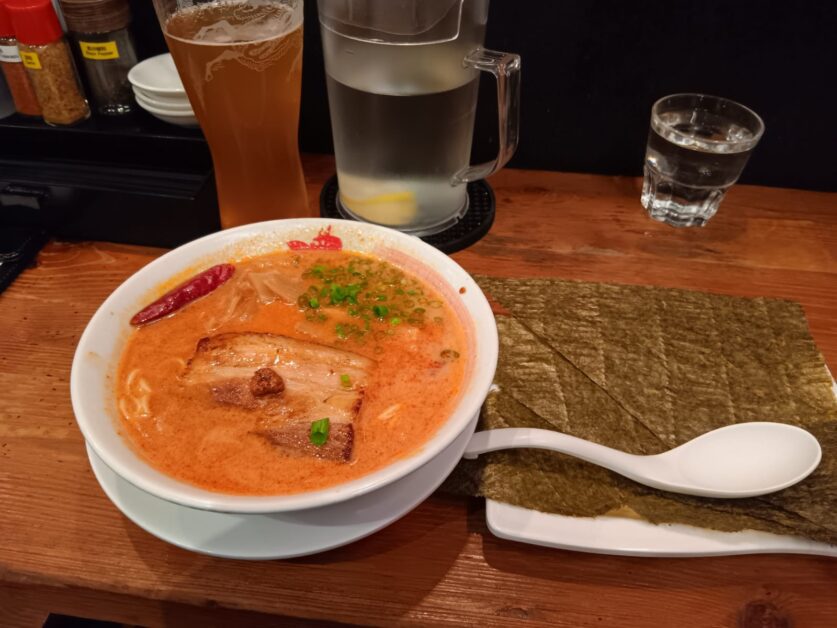
While Ramen Bari-Uma is primarily a tonkotsu ramen-based restaurant, they do also serve up a white broth chicken ramen. At the end of the day, this comes down to preference. I opt for the tonkotsu ramen due to its creaminess and milder saltiness (there is a slight infusion of shoyu in the broth from what I understand). I also find there to be more depth to the broth due to the countless hours spent rendering pork bones down into a distilled elixir.
You can either opt for a signature mild tonkotsu broth or spicy broth. I’m not typically massive on spice but I’m too deep in the spicy ramen game at Bari-Uma to depart from it these days (unless it’s the abura soba mentioned below). It’s cleansing and does sport a lingering spice at the tip of your tongue, which should be no surprise with the red chili(s) you’ll find lining the edge of your bowl. Should you want to dilute some of the spice, consider mixing in an order (or two) of the salty, briny seaweed (nori) sheets.

To offset the thickness and creaminess of the broth, Ramen Bari-Uma uses a signature thin, springy noodle (this is very similar to the infamous Hakata-style ramen originating in Kyushu). This is deliberate. You can’t just have a bowl of ramen that exists on a single texture plane. When thick noodles meet a thicker or creamier broth, it risks melding together into one amorphous blob.
You’ll also find a gargantuan slab of fatty char siu lining the edge of your bowl. Hong Kong ramen restaurants have (for me) erred on the side of serving dried out thick cut slabs of char siu but rest assured at Ramen Bari-Uma, that’s far from the case. It not only retains its moisture but acts as the perfect conduit to soak up excess broth, spice, and richness. Sometimes when I’m in the mood for extra char siu but don’t want to be wheeled out of the restaurant in a stretcher, I opt for the tori chashu (chicken char siu).
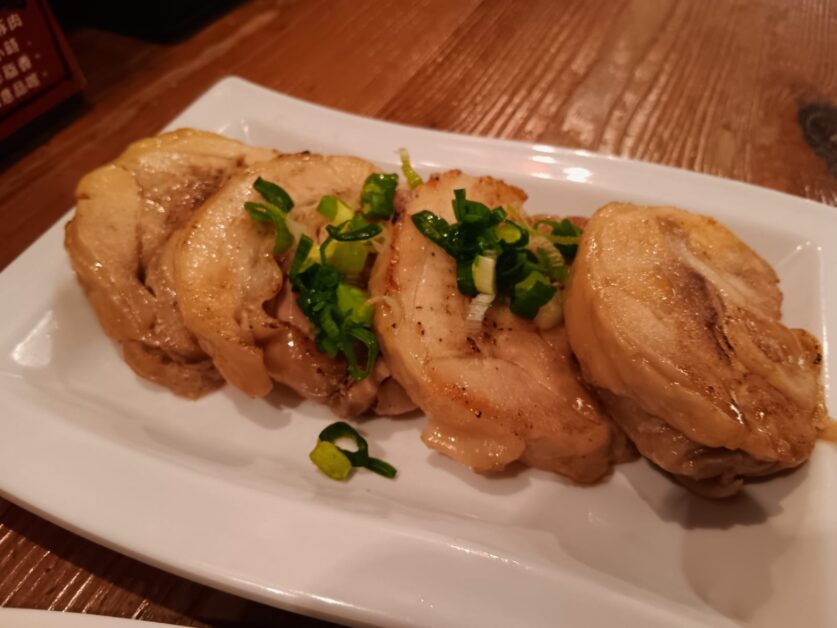
Look at it – the tori chashu in all of its glory.
Ordering a side of the tori chashu would have to be my biggest “in the know” tip. When chicken thighs are rolled, pan-fried, and braised in a salty and sweet soy sauce, an obscene amount of flavor and juice is locked in. Because of this, I prefer to eat these as a standalone side rather than letting it soak side-by-side with its porcine friend.
I’ve only eaten Ramen Bari-Uma’s white chicken ramen once. It isn’t a strictly shio (salt) based chicken broth and I would hazard a guess that it’s thickened with miso to give it a slightly viscous texture. The thickening may also be to provide contrast to the thin vehicle of starch they bathe with. I would recommend ordering this if you want to go lighter for your main meal and instead gorge on the sides below.
Pale Ale Travel Tip: Ramen Bari-Uma is actually a Hiroshima-based tonkotsu ramen chain that boasts over thirty shops across Japan and more than a handful in neighboring countries (including Singapore, Malaysia, and Indonesia). If you are traveling to Japan, I wholeheartedly recommend spending more than a day or two in Hiroshima. The ‘City of Water’ was one of the highlights of my three months in Japan and was the only city I can confidently state that I did not have a single bad meal in. Also, make sure to check out my post on the most popular food theme park in Japan serving up four floors of Hiroshima-style okonomiyaki at Okonomimura.
Learning Your A-B-Ura C’s

I don’t know when I made the switch but it seems to be an emphatic one. I’ve eaten a gosh darn amount of ramen in my day. However, I have thoroughly lacked on the abura soba front. Let’s go through a quick primer on what ‘abura soba’ is.
First, one thing that took me a few weeks in Japan to actually grasp is that most ramen joints use the term ‘soba’ simply to refer to Chinese-style noodles – aka ramen. So no, abura soba does not consist of buckwheat noodles.
Second, also referred to as ‘mazesoba’, abura soba (or aburasoba) is dry (soupless) rather than traditional ramen you may be thinking of which is cozily nestled in a broth bath.
Third, abura soba typically uses a pork lard or soy-based dipping sauce, which is then mixed, along with a variety of other ingredients (including fermented bamboo shoots, green onions, nori, and even raw egg).
Fourth, it’s damn delicious.

Ramen Bari-Uma’s abura soba is like a Korean bibimbap but with thin, springy, eggy noodles, topped with salty nori slices, fresh cucumber chunks, thick cuts of that Canadian bacon-esque char siu, mildly sweet chopped green onions, and thin long julienned slices of watery white hair green onions. It’s served with a raw egg for additional richness that requires some work to mix it together with the rest of the ingredients (but that’s part of the fun).
There’s a contrast of flavors and textures that stand out when ramen is served (a) brothless and (b) at room temperature, as I find that a standard hot broth breaks down a lot of the natural textures of whatever constitutes its internal makeup and coerces it into taking on too many flavor characteristics of the broth. It’s almost like when Eddie Brock in Spiderman is consumed by Venom and becomes a total douche.
For those beaten down by the relentless Hong Kong heat and humidity and are looking for a dish that won’t spike your internal body temperature further, then Ramen Bari-Uma’s abura soba is a must. If you’ve read any of my other posts about living in Hong Kong then you know that I’m one sweaty Betty, caught in a constant struggle of perspiration and stank (not the good type like the ‘Stanky Leg’), so this may be the biggest reason I’ve switched over to a 90% abura soba, 10% traditional ramen dining ratio.
A Drove of Sides & Beerus
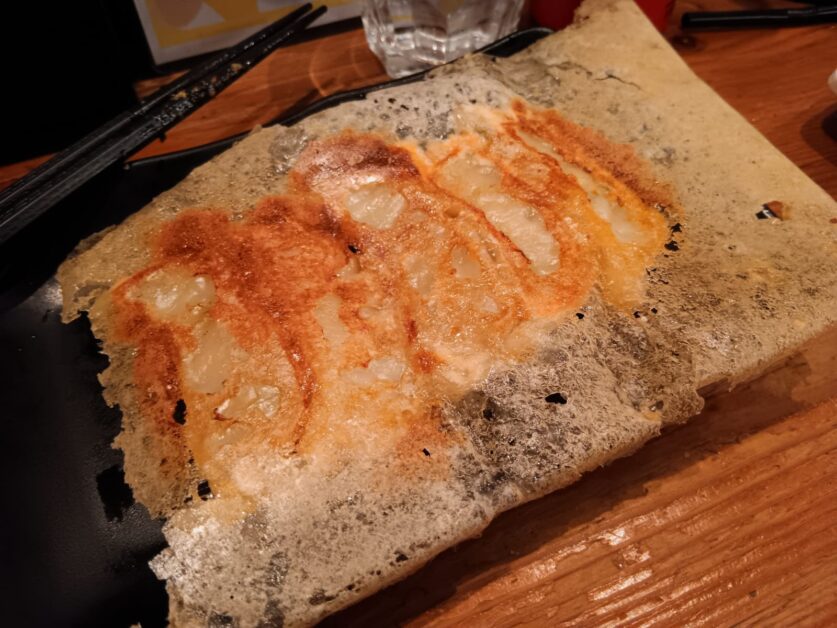
With the gyoza, karaage, and most other sides at Ramen Bari-Uma, you can order them “as is” or customize them to your liking by kicking it up a notch with a teriyaki or spicy chili sauce.
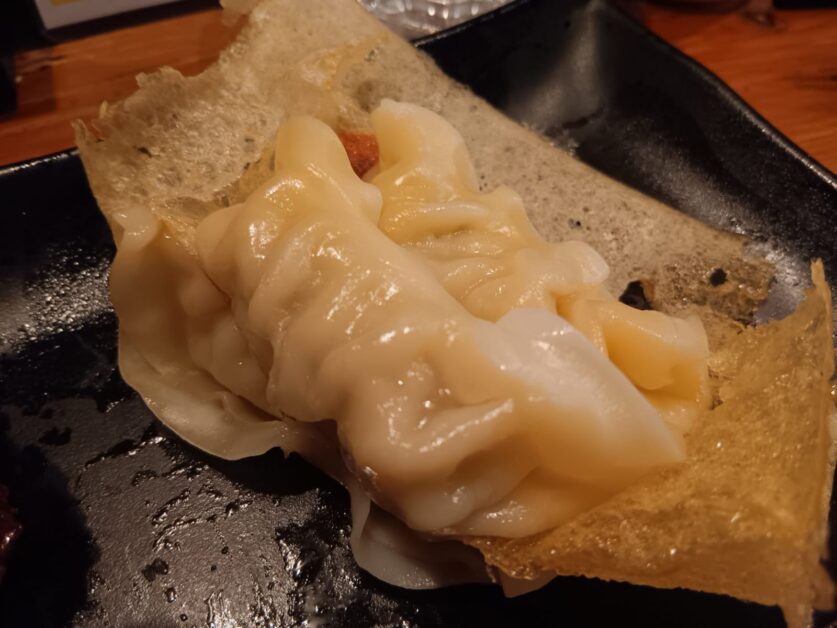
The gyoza are served how I’d argue every batch of gyoza should be served – in brick form. Fried so that an A2-sized wafer of gyoza wrapper (wheat flour, salt, and water) creates a rectangular shape and connects all of the gyoza at the hip. It’s kind of like with nachos where if you grab one nacho but it’s melted to four other chips via its runny yet hardened Monterey Jack cheese, it’s only technically one nacho. So as you can imagine, I eat all four gyoza in one, undignified fell swoop.

The karaage is golden brown and juicy on the inside and generates a satisfying crunch when biting in. My only caveat is that I have occasionally found it to dry out (depending on the day) so I typically cover my bases by ordering it with teriyaki sauce drizzled atop.
The only item on the menu that I’m not a particular fan of is the egg and rice bowl (donburi) with small chunks of char siu. The several times I’ve ordered it, the eggs are just too overcooked and the rice a tad depleted of any remaining moisture.

What may throw you off is the menu actually reads that they have Sapporo beer on draft. However, this was incorrectly written on the menu. Yes, they have Sapporo (my favorite Japanese draft beer) but in can/bottle form. It’s actually Kirin that they have on draft. I’m a sucker for an ice cold Kirin beer. And they come in several sizes – a half pint or a full pint. I’m sure you can guess which one I typically order.
The contrast between a hot bowl of thick, creamy pork bone ramen and a light, crisp Japanese lager (that can play with the best of the lagers out there) is incredibly underrated on the imaginary ‘ bingo card’ of satisfaction that we all keep in our minds.
Kill Bill: Vol. 3 – Ramen Bari-Uma
First, I’m sorry for calling this a tryst. You mean so much more to me than that. That’s why I’m making it known. We’re meant to be together Ramen Bari-Uma and I’m proud to be seen with you in public.
If this post was an early-2000s Quentin Tarantino martial arts revenge film, I know who would be cast as the lead and baddest bride of them all – Ramen Bari-Uma Thurman. I’m thankful to have found a spot that offers me a consistent, quality gastronomic refuge at the end of a hectic day – the only thing left is to explore their Tsim Sha Tsui branch and report back (let me know in the comments how it stacks up to their flagship store in Lan Kwai Fong).
I’m actually heading there as I wrap this blog post up. Mainly because I forgot to take pictures of the gyoza you see above. The sacrifices I make. These little quests that I set out for myself actually give my eating a purpose – otherwise it’s just pure carnage and slovenliness.
If you have any favorite ramen spots in Hong Kong that you think I should check out and would like to see me write about, please let me know in the comments or via email (info@palealetravel.com).
Eat well everyone,
Big Body
Big Body is a voracious lov…eater, a cowardly fighter, and a self-proclaimed curry goat BBQ-eating champion (don’t forget the donkey milk) who likes Stoicism, baseball, and writing in the third person. Having worked for himself for the last 7 years, he isn’t particularly successful but he does still drink ice-cold Sapporo draft beers with the best of them and knows his way around a Dai Pai Dong or two. He is based in Hong Kong but you can still find him in Saigon, Osaka, and Vienna for extended periods.
